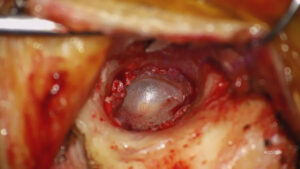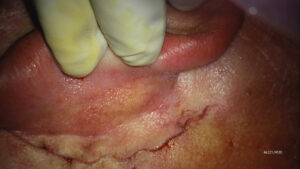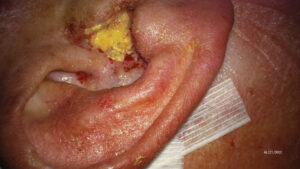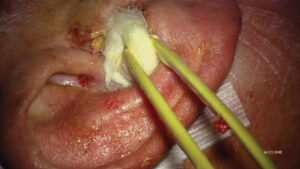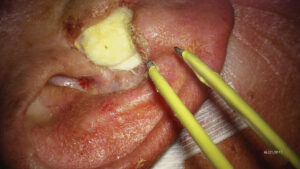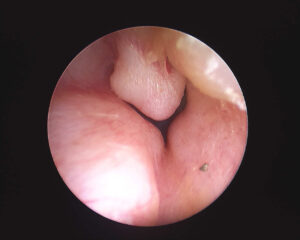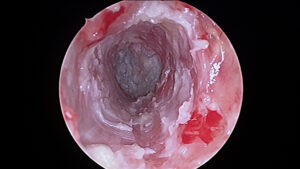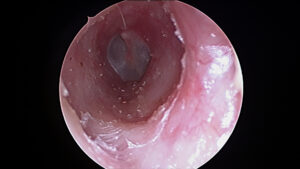The degree of disease and the extent of surgery will determine whether you will be able to go home the same day as surgery, or whether you will need to stay overnight.
In most cases a head bandage is placed that is removed the following day. If an incision is made behind the ear, dissolvable skin sutures are used, and are covered with steri-strips that stay intact for a couple of weeks. You can wash your hair 2 days following surgery.
The ear itself: most deeply a dissolvable dressing called gelfoam is placed. More externally a gauze covered in BIPP, a very strong yellow antiseptic is left for 2-3 weeks. The final dressing is simply a small piece of cotton wool. In the first few days this will need to be changed a number of times a day, due to a small amount of bloody ooze. The most important thing is to keep water from entering the ear. Covering the cotton wool with Vaseline will help with this water prevention. Additionally it will help prevent the BIPP gauze from sticking to the cotton ball and unravelling. If the BIPP gauze does start to unravel, gently attempt to push it back into the ear. It may require a small degree of trimming. Please let me know if there are any difficulties.
In general terms, gentle mobilisation is encouraged the same day as surgery. It is important to avoid bending over and straining, as well as vigorous exercise for the first week, as this can increase the risk of bleeding.
There is usually a mild-moderate degree of discomfort, especially if the ear canal has been widened; as it is very close to the jaw joint, chewing can be uncomfortable for the first few weeks.
With packing in the ear a degree of pressure is felt, and obviously you are left with a significant hearing loss until the packing is fully removed. Not infrequently patients sense a degree of tinnitus during this time.
After any ear surgery you can sense a degree of dizziness for the first week. Any severe spinning or rotational sensation is a warning to contact me.
The first post-operative visit is made 2-3 weeks after surgery, when the BIPP gauze is removed. Often a further gauze is inserted, or an ointment used to fill the ear canal until most of the bone of the ear canal has been recovered with skin.
Infection is uncommon, but any sign of discharge, especially malodorous, and if pain is worsening as opposed to improving gradually suggest this as a possibility.
The post-operative care is very important to optimise the success of surgery in most cases. Regular visits for the first couple of months are necessary.
Video of exostoses surgery with a Z-plasty meatoplasty
A series of photos showing what is used to pack the ear canal immediately after sugery
This usually stays in for the first 3 weeks. It is then removed and replaced with an antibiotic ointment for a further 3 weeks. This is to ensure that skin grows to cover the widened bony ear canal without infection or scarring. The downside is that there will be no hearing for the first 6 weeks, but it is an excellent ear plug allowing water exposure and swimming.
The ear canal after removal of the exostes. There is a wide view of the tympanic membrane, but never enough skin to cover the widened ear canal
Gelfoam (a disolvable sponge) coated with kenacomb (an antibiotic, antifungal and antiinflammatory ointment) is then used to occlude the medial ear canal. We can also see that a Z-plasty meatoplasty has been performed. This is to widen the opening of the ear to match the widened bony ear canal
BIPP (bismuth iodide paste) covered gauze is then used to occlude the lateral half of the ear canal. This is an excellent ear plaug and also sterilises the ear canal minimising the risk of infection
The limited post-auricular incision is then closed with disolvable sutures. (It will essentially be hiddne in the shadow behind the ear
Steristrips are placed over the incision which normally stay in-situ for 3 weeks
A half a cotton wool ball completely covered with ointment (vaseline or paw paw ointment) is then placed on top of the BIPP gauze. This is so water cannot enter the ear, but also so the cotton wool does not stick to the BIPP gauze. A head bandage is applied for the first night. The cotton wool is then replaced a couple of times a day until the first review. The wound behind the ear can be wet 48 hours after surgery, with the steri-strips patted dry, or a hair dryer can be used on a warm setting. This is a good time to replace the cotton wool ball with ointment.
A series of photos outlining the healing of the ear canal following surgery on the left ear.
If you have any questions or problems please call us on 93805380 or email on reception@sydneyentclinic.com. If it is after hours the best number to call is 83821111, which is St Vincent’s Public Hospital and ask to speak to the ENT registrar. If it is urgent call my mobile phone.
In an emergency situation please make your way to the closest major hospital

